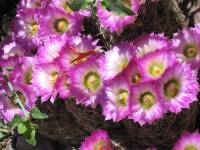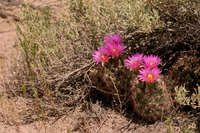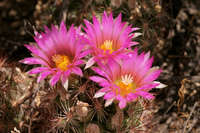Plants usually unbranched or with age in some populations to 30 branches, most branches of largest clumps often immature, stems usually stiff and erect, smooth in immature plants to sparsely and coarsely needle-covered in adult plants. Roots ± diffuse, less than 1/4 of stem diam. Stems usually more than 1/2 above ground (sometimes deep-seated and flat-topped in winter, in cold climates and/or in immaturity), oblate, spheric, ovoid, obovoid, or cylindric with age, 2.5-20 × 3-11 cm; tubercles 8-25 × 3-8 mm, stiff or ± flaccid; areolar glands absent; parenchyma not mucilaginous (except possibly in far north); druses in pith and cortex present, some large, 0.7-1 mm diam., lenticular, usually conspicuous in old parts of stem; pith 1/5-2/3 of lesser stem diam.; medullary vascular system present. Spines 11-55 per areole; radial spines 10-40 per areole, weakly appressed or tightly appressed, pectinately arranged in subadults of some populations, either bright white, ashy white, pale tan, pale pinkish gray, or reddish brown (rarely stramineous), tips dark bright pinkish brown, reddish brown, dark brown, orange-brown, or pinkish orange on all or only largest spines (dark tips rarely absent), 7-22 × 0.08-0.6 mm; subcentral spines sometimes present in adaxial parts of clusters; central spines straight, snowy white, ashy white, reddish brown, sepia, purplish gray, pinkish gray, brownish red, pinkish brown, horn colored, pale tan, dark purplish brown, or stramineous, opaque or vitreous, fading, then blackening with age; outer central spines 3-14 per areole; inner central spines (0-)1(-4) per areole, appressed or strongly projecting, in 'bird´s-foot' arrangement or radiating like spokes, longest spines 9-25 × 0.2-0.7 mm. Flowers slightly subapical, 20-57 × 25-67(-90-) mm; outer tepals conspicuously fringed; inner tepals 21-56 per flower, usually spreading, recurved, pale rose-pink to reddish pink or magenta, sometimes with darker midstripes, sometimes shading to white or pale greenish, proximally magenta, often darkest distally, 15-35 × 1.3-6 mm; outer filaments magenta or basally white (rarely entirely white or greenish white), seldom contrasting with inner tepals and, if so, then paler; anthers bright dark yellow (rarely orange-yellow); stigma lobes 5-13, erect or ascending, white to magenta, 2.5-5.5 mm. Fruits green, exposed portions slowly turning dull brownish red, ovoid to obovoid
Flowering spring-late summer (Apr-Aug); fruiting 2-5 months after flowering. Desert scrub to conifer forest, mostly low hills or mountaintops, diverse substrates; 200-2700 m; Alta., Man., Sask.; Ariz., Calif., Colo., Kans., Minn., Mont., Nebr., Nev., N.Mex., N.Dak., Okla., S.Dak., Tex., Utah, Wyo.; Mexico (Chihuahua, Coahuila, Sonora).
Coryphantha vivipara is the most widespread, abundant and variable member of the genus, but it is rare in Mexico. Reports of it from Oregon, Idaho, and northern Utah are incorrect (A. D. Zimmerman 1985).
In the northwestern part of its range, Coryphantha vivipara may occur with Pediocactus simpsonii, which differs in seed color and texture, fruit dehiscence and succulence, and location of flowers/fruits on the plant; sterile material may be distinguished by spine and bract characteristics.
Coryphantha vivipara flowers are virtually identical to those of C. macromeris and Mammillaria wrightii; in the absence of vegetative material, flowers may be unidentifiable. Some unrelated species, such as C. echinus, vegetatively resemble C. vivipara, but those particular species usually have (1) some of the central spines slightly curved, (2) a few areolar glands present, or (3) no medullary vascular system. The large lenticular druses (to 1 mm wide) in the pith and cortex of C. vivipara are shared only with C. sneedii.
Plants usually unbranched (rarely to 12 branches), usually most protruding above ground level, stiff and strictly erect, densely covered with spines. Roots diffuse or short taproots, largest roots basally less than 1/5 of stem diam. Stems spheric to short cylindric, 3.5-15 × 3.5-9.5 cm; tubercles 9-14 × 4-7 mm, stiff; areolar glands absent; parenchyma not mucilaginous; druses in pith and cortex sporadic, some giant, to 1 mm, lenticular; pith 1/3-1/2 of lesser stem diam.; medullary vascular system conspicuous, diffuse, present even in immature plants. Spines 18-41 per areole, lightly pigmented, white to pale pinkish gray (varying geographically), brightest when fresh, weathering to gray, dark tips present on all or all but smallest spines; radial spines (12-)15-33 per areole, 7.5-16.5(-19) × 0.1-0.4 mm; subcentral spines 1-7 often present adaxially; outer central spines 1-11 per areole; inner central spines (0-)1(-2) per areole, porrect or ascending (other central spines usually not or weakly appressed), in bird´s-foot arrangement or radiating evenly in adults, straight, largest spines 13.5-20.5 × 0.3-0.6(-0.8) mm. Flowers nearly apical, 18-44 × 8-37 mm; outer tepals densely fringed; inner tepals 13-34 per flower, ascending or recurved only at tips, pale dull creamy yellow or pale greenish tan to pale yellow-orange or pale apricot, usually with well-defined darker midstripes of maroon, magenta, pink, brownish orange, or yellow-green, proximally reflective, mirroring anthers, 11-25 × 1.8-2.8 mm; outer filaments white, pale pink, or white with pinkish distal 1/2, not contrasting with inner tepals; anthers bright orange-yellow; stigma lobes 4-11, erect or ascending, white to greenish white, nonstigmatic parts slightly pink, 2.5-4.5 mm. Fruits pale green, exposed parts sometimes dull rose-pink, ellipsoid to ovoid, 12-31 × 5-11 mm, succulent; floral remnant on fruit strongly persistent. Seeds reddish brown, ± obovoid or comma-shaped, 1.4-1.8 mm, pitted. 2n = 22.
Flowering Apr-Jun(-Sep); fruiting time unknown. Desert calcicolous scrub, Larrea scrub, blackbrush scrub, pinyon-juniper woodlands, limestone or dolomite rocky slopes, gravelly bajadas (rarely granite or basalt); (300-)500-1700(-2400) m; Ariz., Calif., Nev., Utah.
Coryphantha chlorantha is vegetatively identical to C. vivipara in the broad sense; without fresh flowers or reliable flower data, only an expert can distinguish C. chlorantha from C. vivipara, with which it sometimes grows sympatrically. Populations of C. chlorantha can be distinguished by their small, less-widely opening flowers, which are usually yellowish or pale pink-and-cream-striped, in contrast with the large, widely opening, purple flowers of C. vivipara.
Common Name: Arizona spinystar
Duration: Perennial
Protected Status: Salvage restriced status in Arizona.
General: Ovoid, solitary stems that form mounds up to 60 cm or more in diameter. The stems are stiff and erect, smooth in immature plants, to sparsely and coarsely needle covered in adult plants, the ovoid to cylindric stems are 5-10 cm long, 5-6.5 cm diameter, stems half above ground.
Spines: There are 5-7 central spines, these red but white basally, 1.5-2 cm long, color may seem to mingle with the mass of radials, the radial spines number 20-30, are white and 1-1.5 cm long.
Flowers: Flower 3.5-5 cm in diameter, the inner tepals deep pink, narrowly lanceolate and acute to mucronate, 2.5-3 cm long and 4.5 mm diameter
Fruits: Green berry 12-25 mm, elliptic and becoming dry, sometimes with few scales.
Ecology: Found on sandy and rocky soils in woodlands and forests from 4,500-7,500 ft (1372-2286 m).
Notes: The reddish-brown central spines make the solitary, clumped, or mounded stems appear much darker than those of other varieties occurring from the mountains of western New Mexico outward. Prefers higher elevations than the other varieties, but is considered rare in many counties in Arizona.
Ethnobotany: Unknown
Etymology: Coryphantha is from the Greek koryphe, for summit or crown, and anthos for flower, referring to the way the flowers crown the stem, while vivipara means bearing bulblets. Arizonica means of or from Arizona.
Synonyms: None, note that Tropicos does not separate out this taxa.
Editor: LCrumbacher, 2010
Common Name: spinystar
Duration: Perennial
Protected Status: No status in Arizona.
General: Pincushion cactus with solitary stems, or clusters of up to 30 stems in older individuals; stems ovoid to cylindric, 3-20 cm high and 4-8 cm diameter; tubercles long and narrow, 3-25 cm long and 3-8 mm wide.
Spines: Spines are dense, obscuring the stem; each areole has 10-40 radial spines and 4-14 cenetral spines; spines are 7-25 mm long, thin, very straight and sharp-pointed, and the radial spines radiate out like bicycle spokes and overlap the spines from neighboring areoles; spines are bright to ashy white with reddish or brownish tips and sometimes stripes.
Flowers: Pale rose-pink to bright magenta, usually in clusters of several flowers around the tops of the stems; flowers 2-6 cm long and 2-7 cm wide; petals many, in several series; outer petals fringed and inner petals spreading and recurved (curled outward), sometimes with darker stripes down the center, or grading from a dark color near the center of the flower to a lighter color near the petal tips.
Fruits: Fruits ovoid to obovoid, 12-28 mm high by 2-20 mm wide, juicy, green, and gradually maturing to a red or red-brown color; containing many seeds.
Ecology: Found in a veriety of habitats and substrates, from 500-9,000 ft (152-2743 m); in the Southwest, usually found above 3,500 ft; flowers April-August.
Distribution: Much of western N. Amer. from Alberta, CAN, south to CA, east to TX; south to c MEX.
Notes: Distinguished by the long narrow tubercles (they appear to go very deep toward the center of the cactus that you cannot see the base of the tubercles); long, thin, straight spines, at least some of which usually have red or otherwise darker-colored tips; no hooked spines and no wool at the base of the spines; pink flowers which grow from the axils of the tubercles around the top of the cactus, but not out of the very center of the top. The species is widespread and variable, with several varieties. Look for it under the genus name Escobaria or Coryphantha. Flora of North America uses the name Coryphantha and does not recognize any varieties; Allred and Ivey (2012) do the same. In our region there are a number of rare varieties, including var bisbeeana, var. arizonica, and var. vivipara which are worth maintaining. Please note that we maintain them here.
Ethnobotany: The fruit is eaten raw and boiled, and is useful in small amounts against diarrhea.
Etymology: Coryphantha is from the Greek koryphe, for summit or crown, and anthos for flower, referring to the way the flowers crown the stem, while vivipara means bearing bulblets.
Synonyms: Escobaria vivipara and others, see Tropicos
Editor: SBuckley, LCrumbacher 2010, FSCoburn 2015, AHazelton 2017
Common Name: Bisbee spinystar
Duration: Perennial
Protected Status: Salvage restriced status in Arizona.
General: Clusters of ovoid blonde spiny balls, solitary or branching, often forming mounds that can be 60+ cm in diameter, the stems 2-7.5 cm long, 2-6 cm in diameter, tubercles 6-9 mm, grooved on upper surface from areole to base.
Spines: Areoles with 3-6 central spines, these white to brown or gray with pink or brown tips, these 1-1.5 cm long, seeming to mingle with the mass of radials. The radial spines variable from 15-30, these white or brown, 9-25 mm long and straight.
Flowers: Flowers bisexual, sessile, with straw yellow inner tepals, the outer tepals yellow-green, pink, magenta, to purplish, radial and narrowly lanceolate, 2.5-3 cm long and about 4.5 mm broad.
Fruits: Green berry 12-25 mm, elliptic in outline, becoming dry, sometimes with a few scales, the perianth persistent.
Ecology: Found on sandy to rocky soils, especially limestone, plains, hillsides, and grasslands from 3,000-5,500 ft (914-1676 m).
Notes: Considered rare in many counties in Arizona. Differs from C. vivipara var. vivipara primarily by number of greater number of central spines.
Ethnobotany: Unknown
Etymology: Coryphantha is from the Greek koryphe, for summit or crown, and anthos for flower, referring to the way the flowers crown the stem, while vivipara means bearing plantlets or bulblets on the leaves or in the inflorescence of the parent plant, while bisbeeana refers to Bisbee, Arizona.
Synonyms: None, note that Tropicos does not separate out this taxa.
Editor: LCrumbacher, 2010
Stems solitary or in clumps, to 30 cm; tubercles elongate, 5-20 mm; areoles moderately woolly; central spines mostly 4, 1 pointing downward, 1-2 cm, red or basally white; radial spines 12-20, 1 cm, white; fls 4 cm, dark purplish-pink; fr green 1.2-2.5 cm; seeds brown, 1.5-2 mm; 2n=22. Dry, grassy plains; w. Minn. to Kans. and Okla., w. to Alta. and Ariz. May-Aug. (Mammillaria v.; Neomammillaria v.) Ours is var. vivipara.
Gleason, Henry A. & Cronquist, Arthur J. 1991. Manual of vascular plants of northeastern United States and adjacent Canada. lxxv + 910 pp.
©The New York Botanical Garden. All rights reserved. Used by permission.


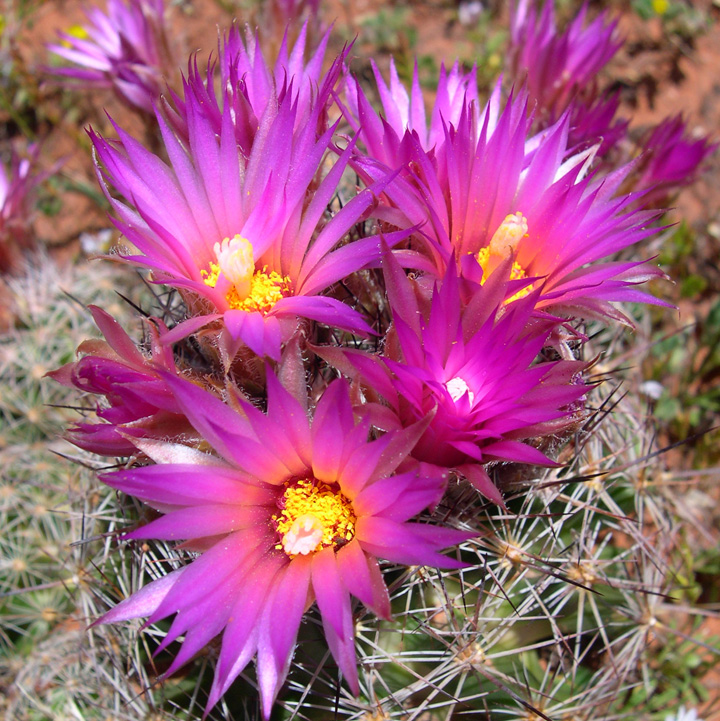
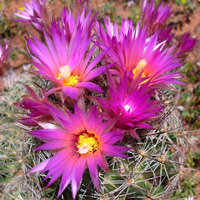
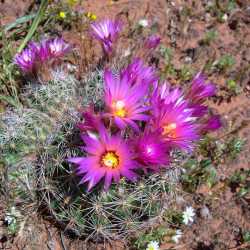
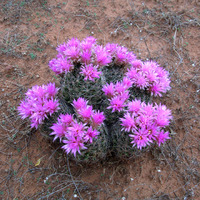
_tn.jpg)
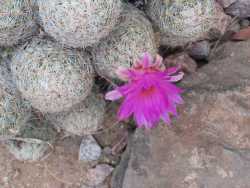
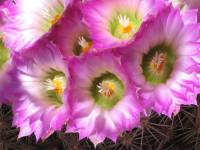
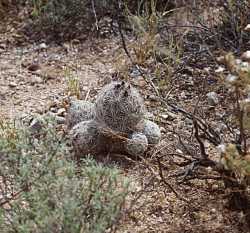
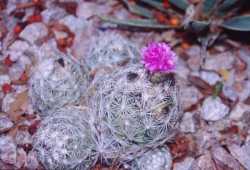
_tn.jpg)
